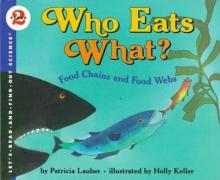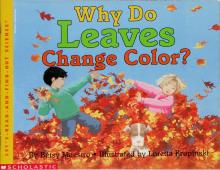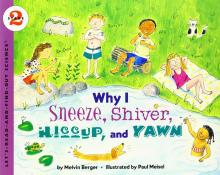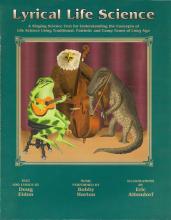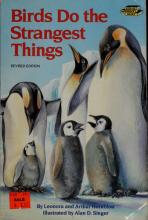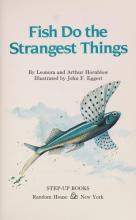Biology / Life Science
Who Eats What? Food Chains and Food Webs
This book explores the notion of various plants and animals that are linked together based on "who eats what." Children will learn about some simple food chains such as – leaf, caterpillar, wren and hawk. They also see how one plant or animal can belong to several food chains and that members or these related food chains (food webs) have a certain amount of dependence on each other. The text goes on to explain, through an example of a problem with over-hunted otters around the turn of the century, that when part of a food chain is disturbed, the other members will also be affected. There are some mild "environmental" messages in this text which our family used as an opportunity to discuss good stewardship of what God has given us.
Why Do Leaves Change Color?
Our family has really enjoyed this book which explains why leave fall off the trees before winter, where the different colors come from, how weather affects the brilliancy of the colors and lots more. It's written in a very simple manner, so that it's quite understandable even for preschoolers or kindergarteners, and yet it contains substantial information so that even moms (like me) realize that they don't know everything : ) You'll also find labeled pictures of the leaves from different kinds of trees, a cross section of a leaf, an explanation of how trees make food, and how to make leaf rubbings and preserve leaves by ironing them between sheets of waxed paper.
Why I Sneeze, Shiver, Hiccup and Yawn
A simple book with cartoon-like illustrations that explains reflexes and the related workings of the nerovus system – focusing, of course, on those four topics mentioned in the title. The story also invites children to try out a few simple experiments to observe reflexes for themselves. A "Find Out More" section provides "Things to Think About", additional "Test Your Reflexes" ideas and "Fun Facts".
Lyrical Life Science
This clever learning set teaches basic concepts in Life Science through cleverly written songs (to tunes like Battle Hymn of the Republic and Dixie). There are eleven songs in all, with a chapter in the text and three pages in the workbook corresponding to each song. These are the song titles:
- "The Scientific Method" (to the tune of "Dixie")
- "All Living Things" (to the tune of "I Love the Mountains")
- "Invertebrates" (to the tune of "Clementine")
- "Coldblooded Vertebrates" (to the tune of "When Johnny Comes Marching Home")
- "Birds" (to the tune of "If You're Happy and You Know It")
- "Algae, Fungi and Nonvascular Plants" (to the tune of "Go Tell Aunt Rhodie")
- "Vascular Plants" (to the tune of "Battle Hymn of the Republic")
- "Protozoa" (to the tune of "Listen to the Mockingbird")
- "Genetics" (to the tune of "Shortnin' Bread")
- "Viruses" (to the tune of "Yankee Doodle")
- "Oh Bacteria" (to the tune of "Oh Susanna")
The song lyrics are very creative and are loaded with worthwhile content. For example, here is the first verse and refrain to the first song, "The Scientific Method" (to the tune of "Dixie"):
Oh, what do you think a scientist does to solve a problem found because many scientists are scientists 'cause they're great problem solvers. There is a systematic way they go about 'most every day. It's methodical and it's logical, The scientific method.
[Chorus:] A way to solve a problem, a way, a way. The scientific method is a way to solve a problem. A way, a way, a way to solve a problem. A way, a way, a way to solve a problem.
Subsequent verses go on to explain the method in detail. My children and I really enjoy singing along with the CD in the car. The songs are performed with a silly tone (imitating the appropriate styles for each song), but by real musicians and with real instruments (no synthesizer – hurray!).
The text, in addition to the lyrics and music (including guitar chords) for each song, contains three to nine pages of information that further explores each topic. Children will memorize the basics (particularly terminology and basic facts) in the songs and then fill in the details by using the text. One could easily introduce the songs to quite young children and use the text a little later on or use the whole set together in upper grade school.
As an example, the segment on "All Living Things" covers (in seven pages) characteristics of living things (reproduce, move, grow, resond to a stimulus, carry on metabolic activities and have a precise structure); needs of living things (energy, water, oxygen, food, living space and proper temperature); the cell as the "building block" of living things; classification of living things and levels of organization. The text is simple and easy to follow and highlighted by pen and ink drawings and charts.
The workbook (reproducible for use in one classroom) includes three pages for each song. A fill-in-the-blanks lyrics page (with a list of words to choose from); an "objective" page (workbook-style review – true or false, matching, questions with short answers, etc.) and a page with a number of short essay-type questions. An answer key is included in the back of the workbook.
I am very impressed with the depth of content, creative presentation and reasonable cost (the workbook may be photocopied for use by your own family, but an additional workbook is only $6!).
A note in the beginning of the text gives some detailed info on how this resource can be used:
This book and CD and tape set can be used by students of many ages. Younger elementary students can benefit by becoming familiar with scientific terms through casual listening, yet may not fully understand the information until later. Middle school students often study life science in six grade; the text and musical arrangements are geared for this age and older students. The information covered in the songs and text should be very familiar to high school students before they study biology in greater depth.
...Ideally, these resources should be in addition to hands-on activities where observations and applications can be made. In this way the knowledge learned through reading and singing can become known through experience as well. You can listen to some sample songs from the CD by clicking here.
Music Performed by Bobby Horton.
91 pg. softcover text, 45 pg. softcover workbook and 30 minute audio CD
This is the first volume of three. The others are "Mammals, Ecology and Biomes," and "Human Anatomy."
Birds do the Strangest Things
Twenty-two stories of the natural but strange and fascinating behavior of various birds. The text covers ostriches, hummingbirds, kiwis, loons, peacocks, emperor penguins, woodpeckers and much more. The text is somewhat lengthy (approx. 12-20 lines per page), but in fairly large print and at a fairly easy reading level. My children find this book completely fascinating. Part of the "Step-Up" series which includes "Meet George Washington" et al.
Fish do the Strangest Things
An informative and enjoyable collection of stories about some very interesting and remarkable fish – such as the Deep Sea Angler, the Archer Fish, the Lungfish, the Puffer Fish and the Mud-Skipper. Although the illustrations aren't fabulous, this book and others in the series have been real favorites with my children. The stories are engaging, fairly short (two to three pages with rather large type) and the content is very appealing. We discovered this book when my daughter was five and for her it became a starting point for a real interest in Sea-Life in particular and Science in general.

